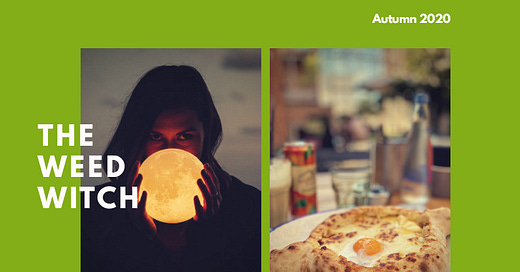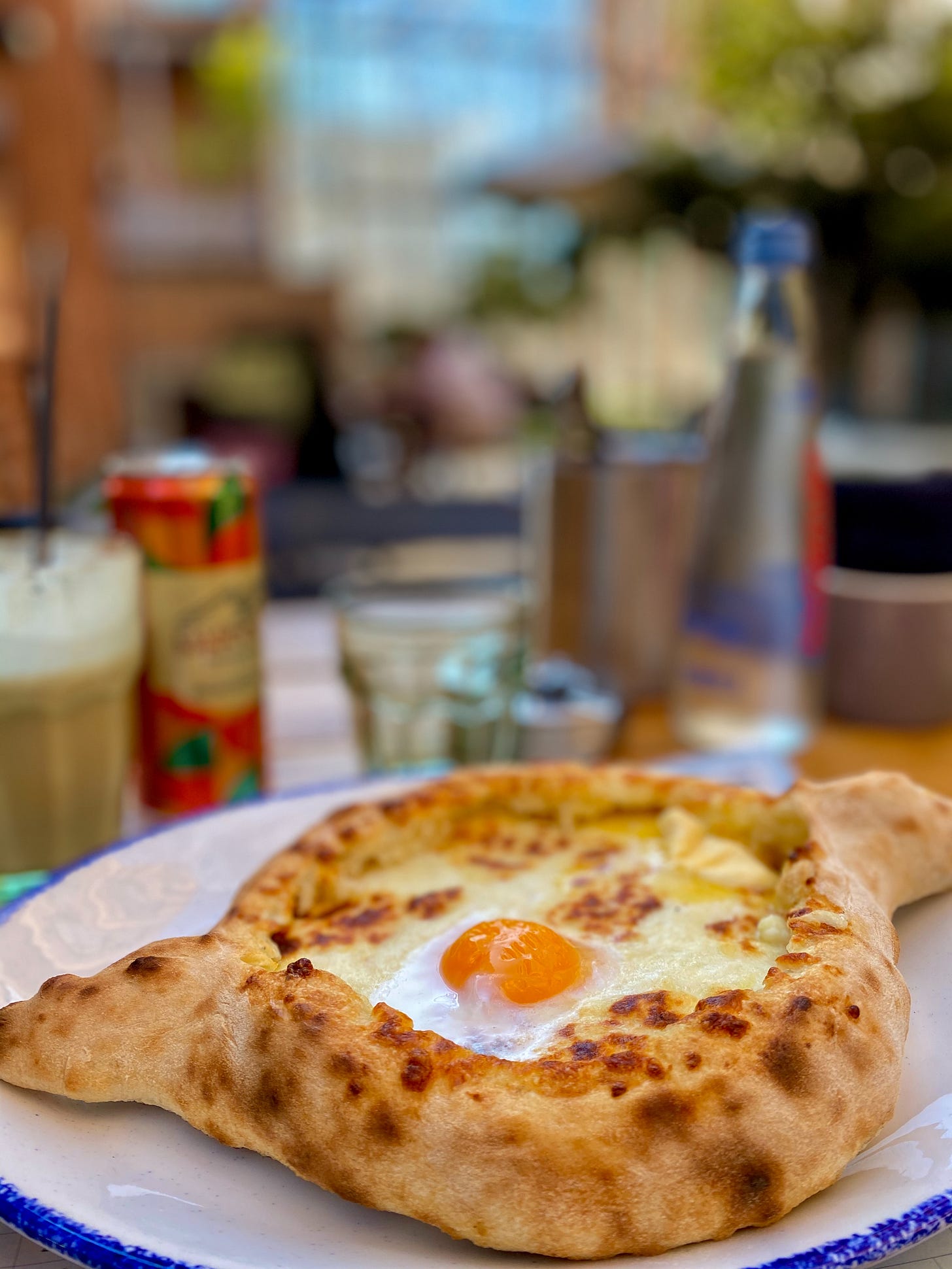#17. How Magical Cheeseboats and Natural Wine Saved Georgia After Soviet Occupation
Plus: A Very Weed Witch Witch House Halloween Playlist
This is The Weed Witch. Feeling stuck somewhere between the real world and the spiritual world? Where truth is stranger than fiction? This is a the friendly guide to cosmic survival. Stream-of-consciousness tales, scrappy DIY craft ideas, and divine wisdom from free-thinking societal outliers, a.k.a. the weed witches. An idea sampler platter and content wildcard for your inbox.
Just like NPR, content for this newsletter is viewer-supported thanks to folks like you, along with limited affiliate links from vetted partners to ensure quality, original content. Upgrade now to a paid subscription for the full experience.
The Prolific Story of How Magical Cheeseboats and Natural Wine Saved Georgia After Soviet Occupation
This week, I was given an incredible opportunity for some mental health relief thanks to the Wines of Georgia, who organized an amazing cooking class and wine tasting featuring Georgian culinary expert and gypsy wine witch and food writer, Carla Capalbo, author of “Tasting Georgia,” (Amazon/IndieBound).
This is the stuff I live for: sharing really cool history through the lens of terroir, where I see the future of cannabis neatly fitting in. Cannabis consumption, by the way, is legal in Georgia as of 2018, making it the first former Soviet country to do this. Benjamin Kemper wrote a pretty great piece for Atlas Obscura on cannabis cooking from the Svans of Georgia.
Georgian wine and food first came onto my radar a couple of years ago when I attended the RAW Wine conference in Brooklyn, bringing in countless producers from all over the world dedicated to the craft of wine typically labeled as “low-intervention,” “naked” or “raw” wine. About a year later, I was invited to attend a Georgian economic summit in Washington, D.C. where I learned that their wine exports were growing in popularity and sophistication, particularly with a resurfaced interest in natural wine.
Natural wines are a pretty contested category in the wine world, but generally, if you like kombucha or beverages with funky flavors, amber wines aged in qveri are typically a pretty wild experience for your tastebuds. Among the most ancient natural winemaking methods in the world, Georgian winemaking is over 8,000 years old and distinguished by its method of aging wine in terracotta casks lined with beeswax called qvevri buried underground, fermented with natural yeast and skin-contact grapes that produce a natural orange color and distinctive flavor.
Before the Soviet era, there were at least 525 native indigenous grape varieties that could only be found in Georgia. However, many of these varietals were discarded during Soviet occupation because they weren’t taken seriously and cooperative wine making methods weren’t interested. As a result, there were only three or four varieties during the Soviet era to appease the occupiers’ tastes, including its most well known varietal, Saperavi.
When the Berlin wall fell, Georgia went into crisis and the country was at risk of being overtaken by mobs. This was a period dubbed “The Black ‘90s” because they never knew when the lights were going to be on—the electricity was constantly at risk of being shut off. However, wine and food culture sustained during these tough times, and actually created a revitalization among winemakers who, once they were permitted to explore the country in the wake of occupation, discovered so many varietals that had previously been lost. Indigenous grapes were found preserved in pockets growing in forests or wherever people were able to grab vines. Today, the national collection is up to 490, which is incredible when you consider what was lost during decades of occupation.
There’s something prolific when you think of this period of time in which so many are in isolation, living with the uncertainty of our own dark ages, theres something beautiful about these heirloom varietals and literal underground winemaking methods remaining amid cultural repression, surviving like weeds in the wild.
Feasts—or supra—are an iconic part of Georgian culture. According to Capalbo, because Georgians are Eastern Orthodox, they often go into fasting mode for Easter, but not in a traditional sense of abstaining from food, but rather giving up meat and dairy. Fasting is veganism in Georgia, which means at every meal, you’ll always find dishes that are good for vegans accustomed to people who are not eating dairy or meat. Walnuts, packed with oil and protein, are very popular to link and bind other things, and they often eat a lot of garlic. Supposedly, more than Italy, if you can believe that.
Khachapuri, Georgia’s iconic cheeseboat dish, is kind of the stoner’s dream: a yeast dough risen into a bread boat and filled with an amalgamation of cow’s milk cheeses and egg. It’s also a beautiful testament to how food and wine are the backbones of shared culture that are worth preserving, because who wouldn’t want a giant cheeseboat, some beautiful wine and a joint to help enjoy all of this! It's also a testament to the incredible resolve in the battle of nature vs. brutalism.
Restaurants like Supra in Washington, D.C., Chama Mama in New York City, Chicago Diplomat Cafe in Chicago, Mimino in San Francisco, Skalka in Seattle, Pomegranate in San Diego, and Armenian-Georgian restaurant Khinkali House in Los Angeles all serve this dish and could use your support. But if you don’t have a Georgian restaurant near you, are on a budget, worried about eating out or just want to cook at home, here’s Capalbo’s recipe to try at home.
Recipe: Adjarian Khachapuri
By Carla Capalbo
Instructions
Follow the Master Recipe for khachapuri using the yeast dough (see below). You will need one egg for the centre of each khachapuri made with 225 g / 8 oz flour, and 15 g / 1/2 oz / 1 tbsp soft butter for serving the bread.
After the yeast has risen, preheat the oven to 170 °C / 325 °F / Gas 3. Place a flat, heavy metal baking sheet on a rack in the centre of the oven.
Punch the dough down, turn it out onto a lightly floured surface and knead for a minute to form an even ball. Roll it into a circle 30 cm / 12 in in diameter on a piece of baking paper. Sprinkle 3 tablespoons of the grated cheese along the top and bottom edges of the dough and roll them in towards the centre to form a boat shape with pointed ends. Pinch the dough to stop it unfolding.
Fill the centre of the ‘boat’ with the remaining cheese mixture (see below). Bake until the crust is golden and the cheese is bubbling, about 25 minutes. Carefully slide a raw egg into the centre of the bread and put it back into the oven for 2 to 3 minutes more. The yolk should still be runny.
Remove from the oven and put the butter on top of the egg. Serve immediately, stirring the egg into the hot cheese and butter.
THE MASTER DOUGH RECIPE (Yeast)
It’s almost as easy to make two breads as to make one, and they can be re-heated if any are left over, so here are the recipes for 1 or 2 breads.
Preparation: 120 minutes (including rising time)
Bake: 25–30 minutes
FOR 2 BREADS, 8 SERVINGS EACH
400 g / 14 oz strong / bread flour
1 tsp sugar
1 tsp quick-acting / instant yeast
1 tsp salt
290 ml / 10 fl oz / 1 1/4 cups warm water
1 tbsp sunflower oil
FOR 1 BREAD, 8 SERVINGS
225 g / 8 oz strong / bread flour
1 tsp sugar
3/4 tsp quick-acting yeast
3/4 tsp salt
150 ml / 5 fl oz / 1/2 cup plus 2 tbsp warm water
1 tbsp sunflower oil
HOW TO MAKE THE DOUGH
You can make these doughs the traditional way – by hand, mixing the warm water into the dry ingredients and kneading on a floured board for 5–7 minutes – or proceed as follows:
Put the flour, sugar, yeast and salt in the bowl of a food processor and process briefly. Pour in the warm water and process again. The dough will come together and form a ball. Continue processing for 2 minutes.
Turn the dough out onto a lightly floured surface. Dust your hands with flour and knead the dough for another 2 minutes. It should be slightly sticky and not too firm. Spread the oil around the bottom and sides of a large bowl. Place the dough ball in the bowl, turning it once to pick up some of the oil. Cover the bowl with a clean tea cloth and place it in a warm place for 90–115 minutes. (If you’re not using the oven for anything else, turn it on low for 5 minutes before you knead the dough. Then put the bowl with the dough into the turned-off oven to rise.)
When the dough has risen, punch it down, turn it out onto a lightly floured board and knead it for just a minute to form a smooth ball. Divide the dough into equal halves if you are making two breads.
Preheat the oven to 170 °C / 325 °F / Gas 3. Place a flat, heavy iron baking sheet in the centre of the oven. Fill and form the bread while the oven heats up.
THE CHEESE FILLING
I like using a combination of four cheeses, in equal parts: For each Imeretian khachapuri I use 60g / 2oz each of grated cheddar, Emmental or other Swiss cheese, mozzarella (firm is best) and cottage cheese, but you can experiment and use your own favourites.
To fill 1 khachapui
225g / 8oz mixed cheeses, at room temperature
freshly grated black pepper
1 egg, beaten
Mix the four cheese in a small bowl. Season with pepper. If you like, also add half of the beaten egg, keeping the rest to paint the top of the bread.
Excerpted from Tasting Georgia by Carla Capalbo. Copyright 2017 Carla Capalbo. Published by Interlink Pub Group.
A Very Weed Witch Witch House Halloween Playlist
Is Witch House having a comeback? For the uninitiated, witch house is the occult electronic music genre that took off in the early 2010s coined by Brooklyn artist Pictureplane and lead by bands like Salem, oOoOO, Ritualz, and Purity Ring. It’s dark, upbeat, tackles horror, occult and other witchy themes, and was most likely fueled by a lot of drugs because Brooklyn + EDM = drugs. Either way, here are some tunes to kick the blues for your very special blue moon Samhain.
ASK A WEED WITCH
Have a question about cannabis, witch life, existentialism or nihilism, bathtubs, or whether reality is a construct? Have a cool story to share? Want to tell me about your favorite products, real life adventure, conspiracy theory, or psychic connection with ghosts manifested from your third eye? Send all your need-to-know questions to itstheweedwitch@gmail.com.







